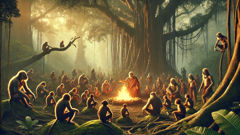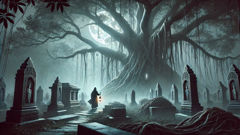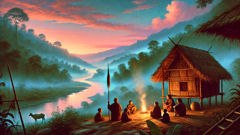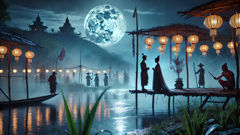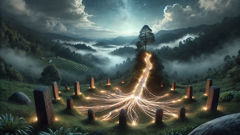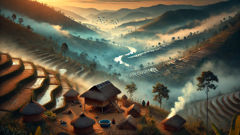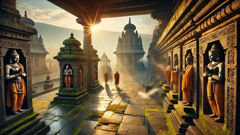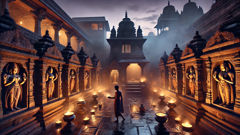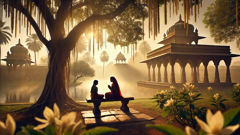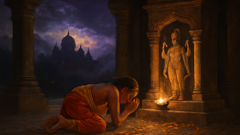Introduction
In the heat-hazed canopy of a subcontinent that still hums with the memory of rivers and kingdoms, there is a people whose story moves like wind through banyan roots: the Vanara, the monkey-like folk who stand both beside and beyond human history. Imagine a world of thick forests and tidal shores, where the rustle of leaves carries council and the dawn finds watchful eyes on high branches. The Vanara are not merely creatures of mischief; in the telling that follows they are a complex race of warrior-craftsmen, scouts, poets, and devout friends who shaped an epic destiny. Led by singular figures such as Sugriva, the quick-witted chieftain, and Hanuman, whose name is a hush of reverence across temples and hearths, the Vanara embody an intensity of loyalty and an unpredictable tenderness. They live by a code woven from the wild—practical, fierce, and compassionate—and by a covenant with dharma that will lead them into fire, across oceans, and into the heart of kingship and sorrow. This narrative seeks to evoke not only the great feats that have been sung, but the small daily life—the chatter at dusk, the craftspeople who carve small idols from driftwood, the herbalists who braid remedies, the storytellers who shape memory—so that readers may meet the Vanara as a people of texture and depth. Through vivid scenes and reflective passages, we will trace imagined origins, social structures, rites, and the decisive moments when their courage altered the course of legend. Approaching these tales with respect for their cultural gravity and a novelist’s eye for detail, the story opens a window into a race that is at once wild and wise, a race whose echo endures wherever devotion and bravery meet.
Origins, Kinship, and the City Among Trees
Across the ragged map of memory and myth, the Vanara take a curious place: neither wholly animal nor strictly human, they stand as a liminal people at the threshold of the wild and the human polity. Stories of their origins vary by storyteller and region. Some speak of a sacred lineage tied to wind and vitality, conceived in the breath of the forest itself; others tell of sages whose enchantments wove sentience into the limbs of monkeys, granting speech, reason, and custom. For the purposes of this narrative, imagine an origin rooted in both prophecy and everyday miracle: a confluence of gods' favor, a forest's deep spirit, and human compassion that led to the emergence of a race capable of both mischief and profound allegiance.
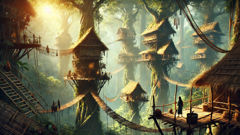
In any imagined Vanara city you will first notice architecture that answers the tree. Their dwellings cling to trunks, nest within boughs, and span chasms with braided vines that are both roads and lifelines. Workshops hang like beehives beneath ribs of foliage; potters shape clay with hands broad and deft; weavers braid rope and banners of leaf and textile. The Vanara are remarkable practical engineers—their bridges of living wood and woven liana are marvels of adaptive design. For travel across perilous ravines they rig pulley-systems and leaplines, while their scouts train wings of rope to steady warriors landing on unfamiliar branches. This intimate, intimate knowledge of environment informs their kinship patterns. Clans bind together by totem and craft—some families are tree-singers who know the health of sap and root, others are stone-workers who read river currents like scripture. Elders keep lineage in the form of ornate bead-strings, quilled and painted with scenes of hunts, births, and oaths.
Their language sits like a river-song between human grammar and animal cadence—a tongue rich with onomatopoeia for wind, bark-sound terms for remote danger, and a deep vocabulary of kinship. Speech is often musical; counsel meetings blend argument with chant. Ritual is the seam that stitches the community: newborns are welcomed by the naming of stars and the placement of a woven amulet at the base of a favorite tree; marriages are oaths tied with vine and exchanged under a canopy of fragrant blossoms; deaths are celebrated through river rites meant to carry the brave to the open ocean of memory. The Vanara calendar is elemental. Festivals follow the tides and the migrations of birds. There are days for hunting, days for mending, days for thanksgiving to the forest spirits who are called by names shaped in the half-light of early morning.
Power among the Vanara is never singular for long. Their chieftain holds sway through charisma, counsel, and capacity for promise; leadership means being able to inspire an island of individuals to move as one. Sugriva, in the stories that ripple outward, is the archetype of a ruler who combines sharp intelligence with an impatient practicality—someone who can negotiate alliances as quickly as he can dispatch a messenger. Hanuman represents a different kind of authority: devotion incarnate. He is not merely a warrior but the moral engine for others. Where Sugriva reads opportunity, Hanuman transfigures love into action—his presence bends the will of the fearful into fearless motion.
Daily life under such leaders is textured. Children are taught stealth as a first lesson, not necessarily for carnage but for silence, for the art of listening. The Vanara do not hunt for sport; they harvest with rules, taking what the land will afford and leaving offerings to maintain balance. They develop extraordinary herbal lore—the tendrils and bark of city trees provide salves that heal bruises and mend splintered bones. Craftspeople build drums whose beats can send signals through ravines; certain songs are encoded warnings for the scouts. War, when it comes, is a communal choreography: feints and acrobatics, centrifugal movement to disorient foes, and the use of forest terrain as a living trap. There is also an ethic of laughter. Humor, sometimes rueful, sometimes absurd, is an organizing force. It keeps elders humane and tempers the heated impulses of youth. The Vanara are permitted mischief because mirth keeps arrogance in check.
Religion in Vanara life is woven with practical reverence. Temples—if the word applies—are groves tended with lanterns and carved stones where figures representing virtue and protection sit. A particular tree may be sacred for generations, its bark polished by hands that have sought counsel there for decades. Priests are not removed from society; they also fish, mend nets, and teach restraint. Festivals feature feats of strength and recitation of past deeds, but the most sacred rites are small: a hand placed on a neighbor's forehead to pass a blessing, a shared meal after a hunt, or the silent watching of stars so the young know the vastness their decisions touch.
The Vanara also maintain complex relationships with neighboring human kingdoms. Sometimes they are aloof allies, guiding hunters and rescuing lost caravans; at other times they are fierce belligerents, for borders move and old insults can fester. Trust is always earned. Many a merchant has learned that to affront a Vanara is to invite months of mischief and sustained exile; conversely, to honor one with proper ritual and gifts opens a channel of remarkably loyal service. This duality—capable of mischief and steadfast fidelity—makes the Vanara an unpredictable but essential element in the great tales of kings and exiles.
Education takes shape around apprenticeship. Young Vanara shadow elders through seasons of weather and work: climbing techniques, medicinal identification, the art of building boats, and the subtleties of speech used to sway both friend and foe. Storytellers, who often double as historians, keep the flame of memory alive. They maintain rolls of woven cloth into which they stitch the names and deeds of ancestors; these cloths are unrolled in councils to remind leaders of oaths. The society’s deep memory, its reverence for promise, explains why an oath to a leader like Rama will be honored with unusual and dangerous fidelity.
In short, the Vanara are an image of a community adapted to a world that values nimbleness more than weight and ingenuity more than sheer force. They are shaped by a survival that has mellowed into culture: a people whose laughter contains prophecy, whose hands make tools and hold hands in equal measure, and whose courage is the kind that can cross an ocean because it is propelled by devotion as much as by muscle.
The Great Journey, Hanuman's Resolve, and the Lasting Legacy
When the Vanara step into the larger sweep of epic fate, their virtues face an unusual test. Their alliance with Rama—an exiled prince bound to a strict sense of kingship and dharma—pulls them from forest rhythms into a campaign that will reach across sea and into the heart of a fallen queen's captivity. In this portion of the tale, we focus on what it means for a people to commit their collective might to a single purpose: the rescue of Sita, who becomes, in story and symbol, the hinge on which duty and devotion turn.
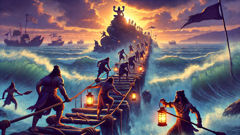
The Vanara response to Rama is not immediate adoration but a slow, rising recognition. At first they are wary of human promises; this hesitation is cultural prudence borne of centuries of boundary disputes and treaties. Sugriva's internal politics complicate matters. Rivalries within the Vanara confederation create fractures that must be reconciled; leaders are called to act as healers of both pride and jealousy. Hanuman emerges in this context not only as a warrior but as an emissary whose presence reframes commitment. His humility becomes contagious. Hanuman listens longer than he speaks; when he speaks, his words are framed like a rope thrown across a ravine—measured, load-bearing, and intended to reach.
Reconnaissance and logistics define the Vanara contribution in pragmatic terms. Their scouts range farther and with greater flexibility than any human unit; they map coastlines by night, learn the currents of small coves, and decode the patterns of enemy patrols with almost botanical accuracy. Their engineers—people accustomed to building bridges and ladders in the living world—become the architects of an improbable crossing. The famed bridge to Lanka, in this narrative, is as much an act of imagination as of construction: a sequence of problem-solving dialogues, in which stones are guided by faith as much as by labor, ropes and human ingenuity translate across open water, and the bind between soldiers is proven by the willingness to carry loads and trust each other's footing. This is not merely an engineering feat; it is a cultural performance: songs to steady the hands, offerings to the sea, and small rituals for each stone placed, as though the ocean must be persuaded as an ally.
Skirmishes and battles highlight Vanara tactics. They rarely meet an adversary head-on without considering the stage—what terrain advantages can be used, what noises will disorient, whether a feint might unravel the enemy's discipline. They use ambush, mimicry, and aerial diversion. The Vanara can act like a flash-flood of bodies and noise collapsing into pockets of silence where reconnaissance parties achieve surgical strikes. Warriors are trained to hit quickly and withdraw before a counter can be organized, to carry messages in the teeth of confusion, and to improvise equipment from the immediate landscape. Their humor again plays a role: pranks can break the tension of a long siege, small acts of absurdity can unnerve even a well-drilled foe.
Hanuman’s greatest contributions are both literal and symbolic. As a scout and messenger he exemplifies courage that is not bravado but calm potency. His feats—leaping great spans, moving with deceptive speed, carrying news and hope—become metaphors for what love can accomplish. But his devotion also poses a model of leadership by service. When the Vanara fight under his influence, they do so not for plunder but as a large-scale act of protection. Their ethic shifts the scale of the conflict: it becomes a moral campaign as much as a political one. This framing matters because it transforms allies into devotees and a military act into an act of sacred duty.
The campaign's human consequences are urgent and intimate. The rescue of Sita is recounted with scenes of exhaustion, of grief, of small acts of tenderness amid the chaos of a war camp. The Vanara show up to comfort the bereaved, to carry water and food, to stitch armor. Their songs, which might seem frivolous in peacetime, become carriers of courage. They sing to embolden the anxious; in the hush between battles, their chants stitch a fragile cohesion back into ranks. The Vanara themselves suffer loss—brothers fall, entire clans are taxed by war's demands. But there is a discipline to their mourning: honors are performed with the same meticulous care with which they once braided rope and mended nets.
After victory—when it comes—what remains of the Vanara's participation is not only trophies but traces in ceremonies, in the exchange of stories, in the names carved into temple stones and in the hearts of people for whom they fought. The Vanara do not vanish into the background; they remain as a liminal, living presence. Shrines appear where great feats occurred; a footfall on a rock becomes a sacred step for pilgrims who wish to touch the place where a friend vaulted to save a queen. Hanuman's devotion, such as it is remembered, becomes a template for later devotional movements: the idea that devotion to righteousness can be an action as potent as a sword.
There are deeper layers to their legacy. Anthropologists of myth might read the Vanara as representing an ethic of ecological intelligence: a culture that values the ability to live within a system rather than attempting to dominate it. Psychologists might see in them the archetype of the trickster-ally: the figure who destabilizes certainty and then stabilizes the world with loyalty. Poets find in their stories a condensed map of virtues—self-sacrifice, agility of mind, and the blessed harm of compassionate mischief. Artists across centuries have painted Vanara scenes not as mere comic relief but as study of motion and devotion: leaps that catch light, hands that lift, faces that watch with concentrated love.
In modern times their echoes continue. Temples to Hanuman are found throughout the subcontinent, where devotees touch metal idols and whisper prayers for courage. Folk plays and village dramas re-enact key episodes, turning ancient battle into moral rehearsal. Children's tales keep the Vanara as teachers of simple virtues: be brave but thoughtful, aid your friend, do not let pride carry you too far. The imagery also permeates popular culture: a hero who leaps impossible distances, a comrade who will hold a bridge steady with his back—these motifs keep appearing because they answer an elemental desire to believe that love and craft can rearrange the world.
Ultimately, the Vanara in this telling are an imaginative mirror. They teach that strength without compassion is brittle and that cunning without commitment is fleeting. They remind us that a people can be both of the earth and in service to a higher law, and that devotion—when honest and practiced—has the power to move mountains and seas, to build bridges literal and spiritual, and to hold rescue as a vocation rather than a one-off heroic act. Their story endures because it is a story about what communities can become when they take oath, neighbor, and promise seriously.
Conclusion
The Vanara endure in imagination because they combine two traits that human cultures find useful and beautiful: nimbleness of body and depth of heart. In this retelling, they are more than side characters in a larger saga; they are a people whose daily practices and dramatic sacrifices show a consistent ethic: to bind life to duty, and duty to compassion. Hanuman's name remains a kind of shorthand for that ethos—the friend who puts another’s need before his own, the one who leaps when asked and returns carrying both news and hope. Across generations, the lessons of the Vanara have been folded into rituals, songs, and simple parental admonitions: be brave, be loyal, remember to repair what you break. In temples and village gatherings alike their image is invoked to steady the fearful and remind the powerful of humility. Their story also offers a particular ecological insight: a community that learns to read the land becomes capable not just of surviving but of forming ethics that honor limits and reciprocity. For readers who find in these pages an echo of their own longing for fidelity and smart courage, the Vanara presents an invitation: to reimagine bravery as a communal craft, to treat devotion as an active force, and to understand that even the wildest of spirits can be shaped by honor. May these recollections of tree-city laughter, of rope-bridges and midnight councils, of songs that turn labor into liturgy, linger like a whispered counsel—reminding us that in the knot of promise and action lies the possibility of crossing not only rivers but, perhaps, the modern gaps in our own courage.

